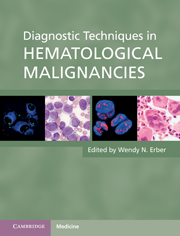4 - Cytogenetics
from Part 1 - Diagnostic techniques
Published online by Cambridge University Press: 06 December 2010
Summary
Introduction
For many years cytogenetic analysis has provided the gold standard tool for basic genetic diagnosis in hematological malignancies. Although resolution is somewhat limited, it provides a global analysis of the entire genome. In recent years a range of fluorescence in situ hybridization (FISH) and high resolution array-based techniques have become integrated into the broader field of cytogenetics, which have provided complementary rather than replacement approaches. They have identified novel and submicroscopic genetic changes, which need to be considered alongside the traditional karyotype.
A number of chromosomal abnormalities provide the definitive diagnosis of a specific type of leukemia. The best known examples include the association of the Philadelphia chromosome (Ph), arising from the translocation, t(9;22)(q34;q11), with chronic myelogenous leukemia (CML) and the translocation, t(15;17)(q22;q21), with acute promyelocytic leukemia (APL). Of particular interest is the strong link between certain abnormalities and outcome, which are used to determine the risk stratification of patients for treatment. For example, the Ph and near haploidy (< 30 chromosomes) are associated with a poor prognosis in childhood acute lymphoblastic leukemia (ALL) and patients with these abnormalities are treated as high risk. Other genetic abnormalities are associated with a favorable outcome, e.g. core binding acute myeloid leukemias (AML) with chromosomal rearrangements t(8;21)(q22;q22) and inversion of chromosome 16, inv(16)(p13q22)/t(16;16)(p13;q22), and childhood ALL with hyperdiploidy (51–65 chromosomes) and t(12;21)(p13;q22). An increasing number of specific gene mutations are being described in the acute leukemias and myeloproliferative neoplasms.
- Type
- Chapter
- Information
- Diagnostic Techniques in Hematological Malignancies , pp. 71 - 89Publisher: Cambridge University PressPrint publication year: 2010
References
- 1
- Cited by



